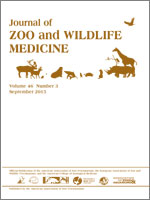Serum samples were collected from 18 lemurs of four diurnal/cathemeral species housed with outdoor access at Bristol Zoo Gardens (United Kingdom) to test 25-hydroxy-vitamin D3 (25OHD3) levels as part of the veterinary department's preventative health care program. Samples were collected from each lemur in August 2008 (summer) and January 2009 (winter) to examine the effect of season on 25OHD3 levels. The lemurs were fed commercial primate food and a range of fruit and vegetables, and dietary levels of vitamin D3 remained the same throughout the study period. Statistical analysis showed that the lemurs' summer 25OHD3 values (range 26.7 to >150.0 μg/L) were significantly higher than their winter 25OHD3 values (range 11.4–87.1 μg/L). UVB measurements taken during the study period confirmed that UVB levels were significantly higher in summer (mean reading for 1200–1300 GMT time period 153.8 μW/cm2) compared to winter (mean reading for 1200–1300 GMT time period 19.4 μW/cm2). The 25OHD3 levels measured were generally found to be high compared to previously published values from wild (free-ranging) lemurs in Madagascar. The most likely explanation for this was the higher vitamin D3 content of the captive lemurs' diet, as UVB levels at the zoo (latitude 51° north) are substantially lower than those that occur in Madagascar (latitude 12°–26° south). No evidence of vitamin D toxicity or deficiency was found in any of the captive lemurs. The results indicate that vitamin D3 levels in lemurs housed with outdoor access in the United Kingdom and by extension, other regions of similar latitude, vary with seasonal environmental UVB levels, in a similar way to the seasonal variations in vitamin D3 observed in humans living in these regions, but that vitamin D levels in this captive lemur population were adequate compared to wild lemur levels, even in winter.
How to translate text using browser tools
1 September 2015
SUMMER AND WINTER VITAMIN D3 LEVELS IN FOUR LEMUR SPECIES HOUSED AT A BRITISH ZOO, WITH REFERENCE TO UVB LEVELS
Rowena Killick,
Richard Saunders,
Sharon P. Redrobe
ACCESS THE FULL ARTICLE
cholecalciferol
lemur
primate
prosimian
UVB
vitamin D





